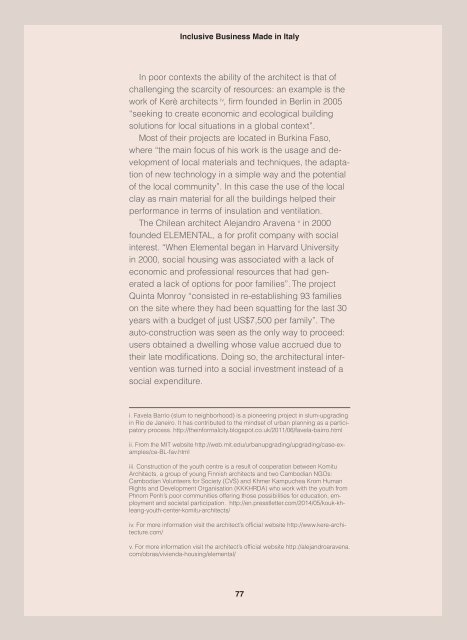INCLUSIVE BUSINESS
Create successful ePaper yourself
Turn your PDF publications into a flip-book with our unique Google optimized e-Paper software.
Inclusive Business Made in Italy<br />
In poor contexts the ability of the architect is that of<br />
challenging the scarcity of resources: an example is the<br />
work of Kerè architects iv , firm founded in Berlin in 2005<br />
“seeking to create economic and ecological building<br />
solutions for local situations in a global context”.<br />
Most of their projects are located in Burkina Faso,<br />
where “the main focus of his work is the usage and development<br />
of local materials and techniques, the adaptation<br />
of new technology in a simple way and the potential<br />
of the local community”. In this case the use of the local<br />
clay as main material for all the buildings helped their<br />
performance in terms of insulation and ventilation.<br />
The Chilean architect Alejandro Aravena v in 2000<br />
founded ELEMENTAL, a for profit company with social<br />
interest. “When Elemental began in Harvard University<br />
in 2000, social housing was associated with a lack of<br />
economic and professional resources that had generated<br />
a lack of options for poor families”. The project<br />
Quinta Monroy “consisted in re-establishing 93 families<br />
on the site where they had been squatting for the last 30<br />
years with a budget of just US$7,500 per family”. The<br />
auto-construction was seen as the only way to proceed:<br />
users obtained a dwelling whose value accrued due to<br />
their late modifications. Doing so, the architectural intervention<br />
was turned into a social investment instead of a<br />
social expenditure.<br />
i. Favela Barrio (slum to neighborhood) is a pioneering project in slum-upgrading<br />
in Rio de Janeiro. It has contributed to the mindset of urban planning as a participatory<br />
process. http://theinformalcity.blogspot.co.uk/2011/06/favela-bairro.html<br />
ii. From the MIT website http://web.mit.edu/urbanupgrading/upgrading/case-examples/ce-BL-fav.html<br />
iii. Construction of the youth centre is a result of cooperation between Komitu<br />
Architects, a group of young Finnish architects and two Cambodian NGOs:<br />
Cambodian Volunteers for Society (CVS) and Khmer Kampuchea Krom Human<br />
Rights and Development Organisation (KKKHRDA) who work with the youth from<br />
Phnom Penh’s poor communities offering those possibilities for education, employment<br />
and societal participation. http://en.presstletter.com/2014/05/kouk-khleang-youth-center-komitu-architects/<br />
iv. For more information visit the architect’s official website http://www.kere-architecture.com/<br />
v. For more information visit the architect’s official website http://alejandroaravena.<br />
com/obras/vivienda-housing/elemental/<br />
77


